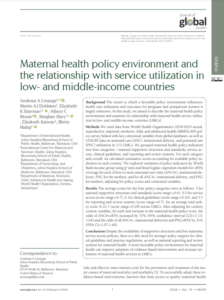
Background: The extent to which a favorable policy environment influences health care utilization and outcomes for pregnant and postpartum women is largely unknown. In this study, we aimed to describe the maternal health policy environment and examines its relationship with maternal health service utilization in low- and middle-income countries (LMICs).
Methods: We used data from World Health Organization’s 2018-2019 sexual, reproductive, maternal, newborn, child, and adolescent health (SRMNCAH) policy survey linked with key contextual variables from global databases, as well as UNICEF data on antenatal care (ANC), institutional delivery, and postnatal care (PNC) utilization in 113 LIMCs. We grouped maternal health policy indicators into four categories – national supportive structures and standards, service access, clinical guidelines, and reporting and review systems. For each category and overall, we calculated summative scores accounting for available policy indicators in each country. We explored variations of policy indicators by World Bank income group using χ2 tests and fitted logistic regression models for ≥85% coverage for each of four or more antenatal care visits (ANC4+), institutional delivery, PNC for the mothers, and for all ANC4+, institutional delivery, and PNC for mothers, adjusting for policy scores and contextual variables.
Results: The average scores for the four policy categories were as follows: 3 for national supportive structures and standards (score range = 0-4), 5.5 for service access (score range = 0-7), 6. for clinical guidelines (score range = 0-10), and 5.7 for reporting and review systems (score range = 0-7), for an average total policy score of 21.1 (score range = 0-28) across LMICs. After adjusting for country context variables, for each unit increase in the maternal health policy score, the odds of ANC4+>85% increased by 37% (95% confidence interval (CI) = 1.13-1.64) and the odds of all ANC4+, institutional deliveries and PNC>85% by 31% (95% CI = 1.07-1.60).
Conclusions: Despite the availability of supportive structures and free maternity service access policies, there is a dire need for stronger policy support for clinical guidelines and practice regulations, as well as national reporting and review systems for maternal health. A more favorable policy environment for maternal health can improve adoption of evidence-based interventions and increase utilization of maternal health services in LMICs.